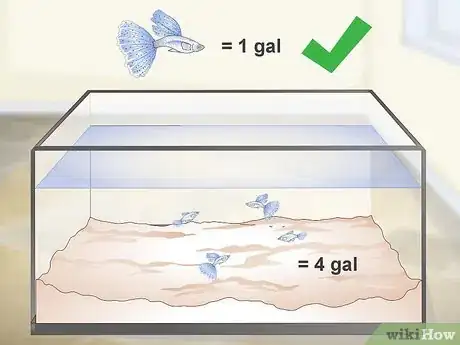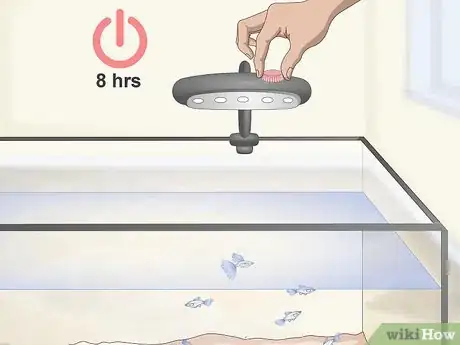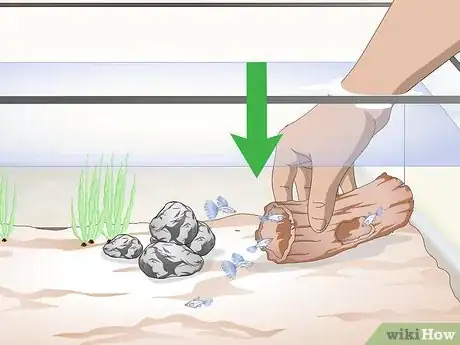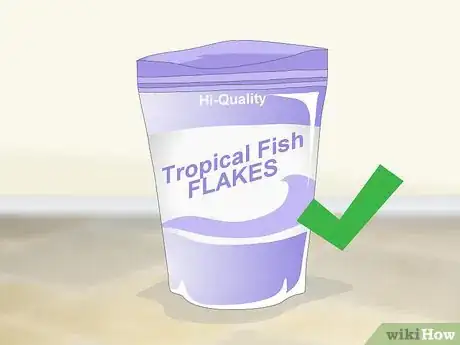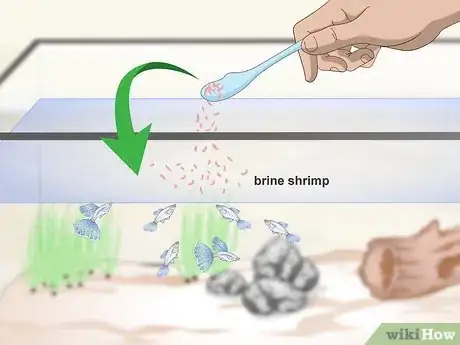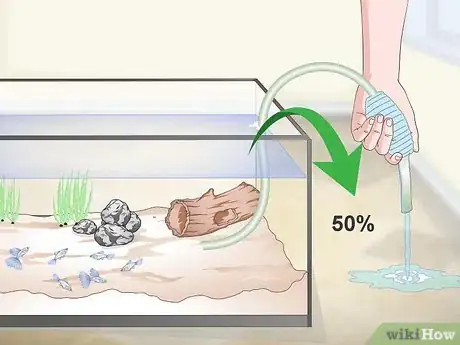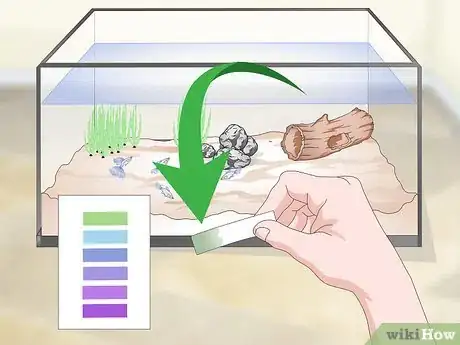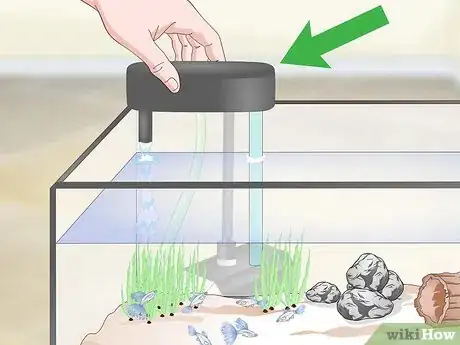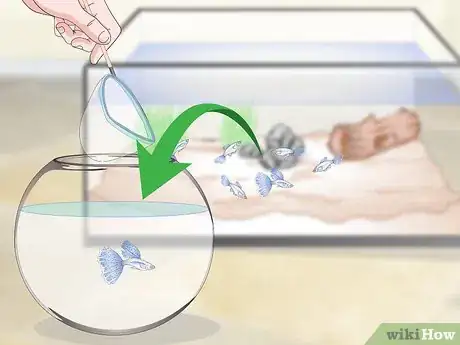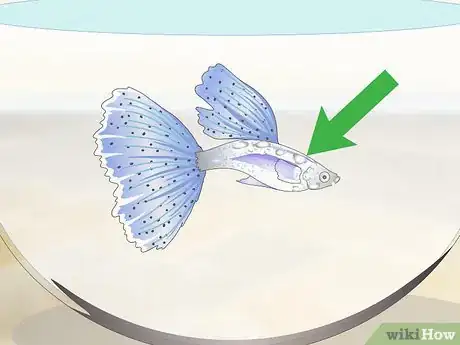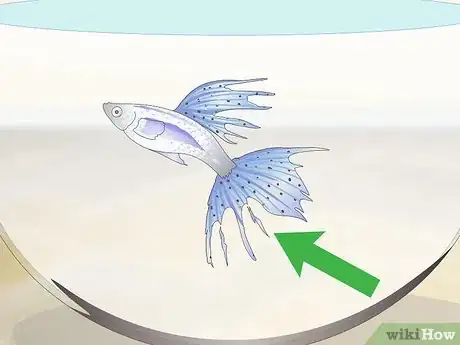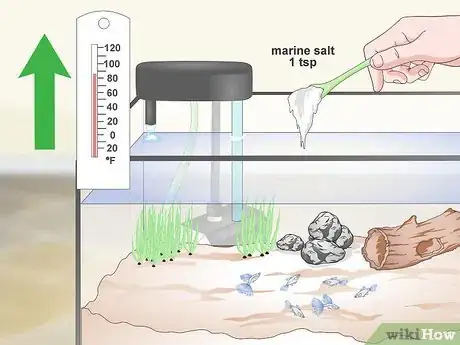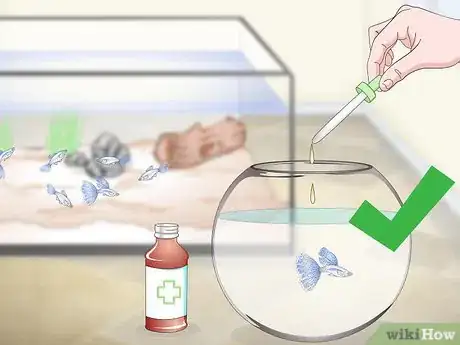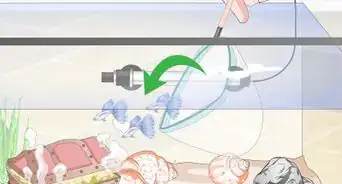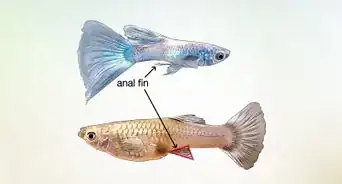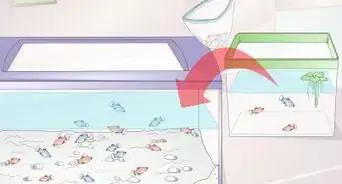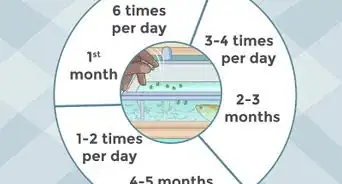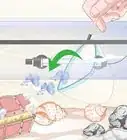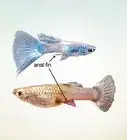This article was co-authored by Doug Ludemann and by wikiHow staff writer, Sophia Latorre. Doug Ludemann is the owner and operator of Fish Geeks, LLC, an aquarium services company based in Minneapolis, Minnesota. Doug has worked in the aquarium and fish-care industry for over 20 years, including having worked as a professional aquarist for the Minnesota Zoo and Shedd Aquarium in Chicago. He received his Bachelor of Science in Ecology, Evolution, and Behavior from the University of Minnesota.
There are 8 references cited in this article, which can be found at the bottom of the page.
wikiHow marks an article as reader-approved once it receives enough positive feedback. In this case, 83% of readers who voted found the article helpful, earning it our reader-approved status.
This article has been viewed 304,539 times.
Guppies are the most common freshwater aquarium fish and they have beautiful and unique patterns and colors. Guppies are relatively easy to care for, and are great fish for people with little aquarium experience. However, poor water quality can lead to several illnesses that could kill your guppies. Ensure the pH and temperature of the water are within the recommended ranges, and clean the tank at least once per month.[1] Provide filtration, light, and hiding spots in the tank, and feed your guppies a varied diet to ensure they stay healthy.
Steps
Providing the Best Habitat
-
1Provide 1 gallon (3.8 L) of water for each guppy. Though guppies are small fish, they still require plenty of space for swimming. Your tank should be large enough to provide 1 gallon (3.8 L) of water for each guppy, so if you have 4 guppies, for example, you’ll need a 4 gallon (15 L) tank. If your tank becomes overcrowded, the guppies may get sick or die.[2]
-
2Use a 1:2 male to female ratio for guppies. You can choose to keep all male or all female guppies. Alternatively, if you want both sexes, choose twice as many females as males. If you have more males than females, the males may chase and harass the females, which can kill them.[3]
- In order to breed guppies, you’ll need to set up a separate breeding tank to protect the fry from other fish.
Advertisement -
3Turn off the lights for at least 8 hours per day. Guppies need light to thrive during the day, but constant light can actually kill them. Set your tank light on a timer so that it goes out and night and provides the guppies with time to rest and recharge.[4]
-
4Provide hiding spots to reduce stress. To keep your fish healthy, they need to feel safe and secure. Hiding spots, like caves, tubes, logs, and plants, give guppies somewhere to rest and relax. Ensure there are enough hiding spots for all the fish in the tank.[5] The best plants for beginners are Java Ferns and Anubias.[6]
- Only put aquarium-safe decorations in the tank.[7]
Feeding Guppies
-
1
-
2Offer flakes once or twice per day. Offer as many flakes as your guppies can eat in several minutes each morning and night. If the guppies don’t eat right away, or don’t eat all the food, skip their next feeding. Overfeeding your guppies can lead to health issues and even death.[10]
-
3Supplement with live food once per week. Fresh or frozen brine shrimp, fruit flies, mosquito larvae, daphnia, bloodworms, micro worms, and earthworms are all suitable options. Offer a small amount of cut-up live food once per week in place of flake food.[11]
Maintaining Water Quality
-
1Clean the tank regularly. Change half the water every week to ensure the tank remains clean. Fully clean the tank, including the gravel or substrate and the equipment (such as a filter), once per month to remove parasites that could harm your guppies. Be sure to test and adjust the temperature and pH of new water before adding it to the tank.[12]
- When cleaning the tank, place the fish in a holding tank or in small containers full of water that meet the pH and temperature requirements.[13]
-
2Keep the water temperature between 50 and 84⁰ F (10 and 29⁰ C). Fluctuations in temperature, especially if they are drastic, can stress out your guppies. Water temperature above or below the recommended levels can cause your guppies to perish. Use a tank thermometer to ensure the water temperature remains consistent.[14]
- Add a small amount of hot or cold water (such as ¼ cup (59 m) at a time) to the tank to adjust the temperature. Repeat every few hours as necessary to ensure the change doesn’t shock your fish.
-
3Maintain a pH of 6.8 to 7.8. It’s important to keep the pH balanced to ensure your fish remain healthy.[15] You should regularly measure the pH of the water using a pH meter or litmus paper and adjust it if necessary. Lower the pH using an acid buffer, or raise it using an alkaline buffer.[16]
- Alkaline and acid buffers are available from your local aquarium store and online.
-
4Install a filtration system. A proper filtration system is necessary to keep the water clean and your guppies healthy. Replace half of the filter media when you notice it turning brown. Avoid replacing all of the media, which can remove the healthy bacteria from the water and harm your fish.[17]
- Filtration systems are available online and at aquarium shops.
Caring for Sick Guppies
-
1Quarantine new and sick fish. When you introduce new guppies into a tank, they may carry bacteria and parasites along with them, which can infect other fish in the tank. The best solution is to keep them in a separate tank for at least 1 month to see whether they are carrying any pathogens. Sick fish should also be quarantined until they recover so they don’t infect their tank mates.[18]
-
2Identify fungal infection. If your fish’s body has white cotton or wool-like patches on its body or if white edges appear around the mouth, it is suffering from a fungal infection called ich. Fish with ich may also lose their appetites and rub their body against rocks or decorations in the tank.[19]
-
3Recognize bacterial infection. A disintegrating or shredding tail or fin (not due to nipping from another fish) is called rot and is a bacterial infection. If the fish’s scales or eyes protrude from its body, it is suffering from a bacterial infection called dropsy.[20]
-
4Treat fungal infections by raising the water temp or adding marine salt. Sometimes, fungus can grow in your tank and on your fish when the water temperature is too cold. Check the tank temperature and slowly increase the heat of the water, if necessary. You can also add 1 teaspoon (4.9 mL) of marine salt per 1 gallon (3.8 L) of water to treat fungal infections.[21]
- Marine salt is available online and at aquarium stores.
- Marine salt is one of the least harmful ways to treat infections in fish.[22]
-
5Provide antibiotics for bacterial infections. Visit your aquarium store or contact your veterinarian if one of your guppies has fin or tail rot, dropsy, or another bacterial infection. Explain the situation and ask for an antibiotic to treat your fish. Follow the instructions for administering the medicine carefully to ensure your fish will recover completely.[23]
Expert Q&A
-
QuestionHow can I get rid of the excess algae growing in my guppy's fish tank?
 Doug LudemannDoug Ludemann is the owner and operator of Fish Geeks, LLC, an aquarium services company based in Minneapolis, Minnesota. Doug has worked in the aquarium and fish-care industry for over 20 years, including having worked as a professional aquarist for the Minnesota Zoo and Shedd Aquarium in Chicago. He received his Bachelor of Science in Ecology, Evolution, and Behavior from the University of Minnesota.
Doug LudemannDoug Ludemann is the owner and operator of Fish Geeks, LLC, an aquarium services company based in Minneapolis, Minnesota. Doug has worked in the aquarium and fish-care industry for over 20 years, including having worked as a professional aquarist for the Minnesota Zoo and Shedd Aquarium in Chicago. He received his Bachelor of Science in Ecology, Evolution, and Behavior from the University of Minnesota.
Professional Aquarist Change the water. Algae is the result of light and nutrients in the water. It doesn't even need a surface to start growing. The cheapest and the easiest way to reduce the algae in your tank in most situations is through water changes. A system like a protein skimmer can also remove compounds from your aquarium, as it eliminates things like food and fish poop from the water.
Change the water. Algae is the result of light and nutrients in the water. It doesn't even need a surface to start growing. The cheapest and the easiest way to reduce the algae in your tank in most situations is through water changes. A system like a protein skimmer can also remove compounds from your aquarium, as it eliminates things like food and fish poop from the water. -
QuestionWhat should I do if I suspect my guppy is sick?
 Doug LudemannDoug Ludemann is the owner and operator of Fish Geeks, LLC, an aquarium services company based in Minneapolis, Minnesota. Doug has worked in the aquarium and fish-care industry for over 20 years, including having worked as a professional aquarist for the Minnesota Zoo and Shedd Aquarium in Chicago. He received his Bachelor of Science in Ecology, Evolution, and Behavior from the University of Minnesota.
Doug LudemannDoug Ludemann is the owner and operator of Fish Geeks, LLC, an aquarium services company based in Minneapolis, Minnesota. Doug has worked in the aquarium and fish-care industry for over 20 years, including having worked as a professional aquarist for the Minnesota Zoo and Shedd Aquarium in Chicago. He received his Bachelor of Science in Ecology, Evolution, and Behavior from the University of Minnesota.
Professional Aquarist For hobbyists, I would advocate a watch and wait approach. Put it in a hospital tank, meaning a bare bones tank with a simple filter and simplistic decor, and wait for a period of time. Research online for possible disease symptoms you may notice and do your best for treatment. Don't add the fish back to the system until it has been healthy for a period of 30 days straight.
For hobbyists, I would advocate a watch and wait approach. Put it in a hospital tank, meaning a bare bones tank with a simple filter and simplistic decor, and wait for a period of time. Research online for possible disease symptoms you may notice and do your best for treatment. Don't add the fish back to the system until it has been healthy for a period of 30 days straight. -
QuestionDo real plants make the water bad for guppies?
 Community AnswerOn the contrary, live plants make the water healthier for them. The more live plants, the better. The plants provide hiding places and help filter the water.
Community AnswerOn the contrary, live plants make the water healthier for them. The more live plants, the better. The plants provide hiding places and help filter the water.
References
- ↑ Doug Ludemann. Aquarium Care Professional. Expert Interview. 27 August 2019.
- ↑ http://www.theaquariumguide.com/articles/how-to-care-for-guppies
- ↑ http://www.theaquariumguide.com/articles/how-to-care-for-guppies
- ↑ http://guppyaquarium.com/guppy-fish-care-guide/
- ↑ Doug Ludemann. Aquarium Care Professional. Expert Interview. 27 August 2019.
- ↑ http://guppyaquarium.com/guppy-diseases-and-treatment/
- ↑ Craig Morton. Fish & Aquarium Specialist. Expert Interview. 21 July 2020.
- ↑ Doug Ludemann. Aquarium Care Professional. Expert Interview. 27 August 2019.
- ↑ https://www.keepingtropicalfish.co.uk/fish-database/guppy/
- ↑ https://www.keepingtropicalfish.co.uk/fish-database/guppy/
- ↑ https://www.keepingtropicalfish.co.uk/fish-database/guppy/
- ↑ http://www.theaquariumguide.com/articles/how-to-care-for-guppies
- ↑ Doug Ludemann. Aquarium Care Professional. Expert Interview. 27 August 2019.
- ↑ http://www.theaquariumguide.com/articles/how-to-care-for-guppies
- ↑ Doug Ludemann. Aquarium Care Professional. Expert Interview. 27 August 2019.
- ↑ http://guppyaquarium.com/aquarium-tank-water-quality/
- ↑ http://guppyaquarium.com/guppy-fish-care-guide/
- ↑ Doug Ludemann. Aquarium Care Professional. Expert Interview. 27 August 2019.
- ↑ http://guppyplace.tripod.com/Ailments.html
- ↑ http://guppyplace.tripod.com/Ailments.html
- ↑ http://guppyplace.tripod.com/Ailments.html
- ↑ Craig Morton. Fish & Aquarium Specialist. Expert Interview. 21 July 2020.
- ↑ http://guppyplace.tripod.com/Ailments.html
- ↑ Craig Morton. Fish & Aquarium Specialist. Expert Interview. 21 July 2020.
About This Article
To keep your guppies healthy, provide at least 1 gallon of water for each guppy so the tank is not overcrowded. Additionally, measure the pH of the water regularly with a pH meter or litmus paper to check that it’s within the range of 6.8-7.8. You’ll also need to clean your tank once a month to remove any parasites that can harm your fish. Then, feed your guppies high-quality tropical fish flakes 1-2 times a day, and feed them live food, like earthworms, once a week instead of fish flakes to supplement their diet. For more tips, like how to care for sick guppies, read on!

